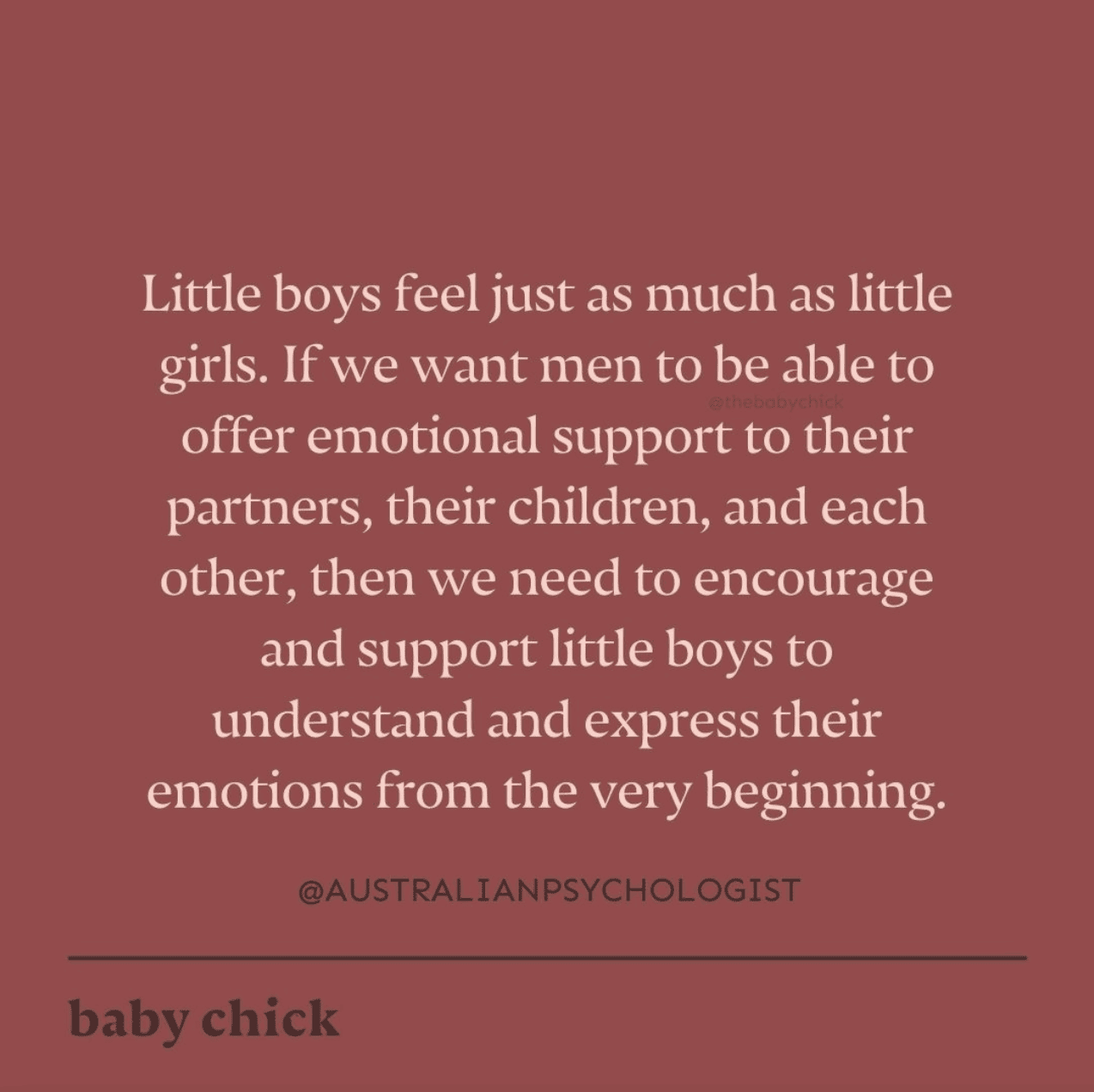“Only girls cry!” “Stop being such a wimp!” These are common messages our boys are given when they show emotions like fear and sadness. Boys are taught from a young age that having these emotions is something they should be ashamed of, and having strong emotions or showing them makes them less masculine. Instead of validating our son’s emotions, society dictates that we teach them to avoid or hide them.
While we know the world is slowly changing in this regard, many people still try to protect their boys from ridicule or bullying in the “real world” by trying to stop their son’s emotions. Often, it comes from a place of wanting (misguidedly) to protect them from other people’s perceptions. But the greater damage comes from having a whole range of other emotions that they are disconnected from and unable to express in healthy and adaptive ways.
The Trouble With Emotions
There are six universal emotions: sadness, disgust, fear, happiness, anger, and surprise.1 What makes them universal is that regardless of culture, upbringing, personality type, etc., humans are capable of recognizing and feeling these six emotions. Only two emotions might be considered positive: happiness and surprise. But we all know that surprises can sometimes be wonderful or horrendous.
Emotions (while unpleasant and unenjoyable at times) can tell us many different things. They occur in response to a stimulus or “stuff” happening around us and help keep us safe or alert us to unmet needs. Some emotions can result in significant and sometimes unpleasant physical responses like cold sweats, tense muscles, tears, etc. This tells us that we better pay attention to important things in our environment, things we need to notice, change, work through, or understand.
The trouble with emotions is that most people only want to experience positive emotions. Not only do many people want to actively avoid certain feelings, but there are some unpleasant and unhelpful beliefs our society can hold about emotional expression. In particular, emotions somehow align with gender, and certain emotions align with being inherently male or female. Essentially society expects or teaches boys to have a narrower range of emotions. Society teaches them to avoid or suppress sadness and fear, but anger is acceptable or appropriate to express (it is seen as a masculine trait).
Extensive research shows people are more likely to allow female children to feel fear or sadness and provide them with more comfort when expressing these emotions than male children.2 Studies also tell us that even our conversations with male and female children are different. Conversations with female children are more likely to address a wide range of emotions, and we tend to discuss them more often. Whereas conversations with boys tend to focus less on emotions or primarily on anger.2

Does Expressing Sadness or Fear Make My Son a Wimp?
No! Just because we don’t teach our boys what sadness feels like (or fear) and how to express it doesn’t mean they will not experience it. An emotion isn’t something you can control. It is automatic and occurs in response to our environment and our needs. So being sad or afraid doesn’t make your boy a wimp. And validating your son’s emotions will help him manage his feelings healthily.
When we focus only on anger or don’t validate and support them when they feel frightened or sad, we are depriving our boys of being able to get their needs met. This can result in confusion, frustration, and even more fear because they don’t feel that the world is safe or trust that others can meet their needs. And if we don’t help them understand their internal experiences, they can feel very distressed. All they can feel are the sensations of a feeling in their body without any context about why it’s happening or how to help themselves manage it.
In addition, despite having a range of emotions, if we only ever speak to our boys about anger, that’s all they learn. It can become a vicious cycle. It feels uncomfortable when they experience another feeling they don’t know how to manage. They don’t know what’s happening or how to fix it, so they get frustrated and angry. So that’s the emotion we see (anger) and the behavior we name and discuss with them. So the vicious cycle starts. When our boys become angry and shut off their other feelings, this can negatively influence their relationships, well-being, and safety.
How Can I Validate My Son’s Emotions?
1. Avoid gendered language.
Firstly, try and remove gendered language around feelings. For example, “Crying is for girls.” “Man up.” There is no such thing as a boy or girl feeling. Emotions are universal and essential!
2. Don’t minimize feelings.
Avoid minimizing your child’s feelings (girls included!) by accidentally rushing through their feelings or reducing how big you think they are. Try to avoid saying things like, “It will be okay. Don’t cry.” Or “It can’t be that bad!” This tells your child that their problem isn’t that big of a deal or important. They learn to avoid their emotions and, in turn, don’t get their needs met. These comments can come from a kind place of not wanting your child to feel distressed and wanting to take their pain away. But they must learn feelings are nothing to be afraid of. They then become open to identifying them. They are better equipped to cope and manage when they understand emotion and why it is happening.
3. Name that feeling!
Give your son the vocabulary to speak about and understand many different emotions. Some strategies can include:
- Name different feelings that you see your child express. When you give their feelings a label, it helps them understand what’s happening. Validating them also reduces the intensity of the emotion and helps build your connection with them (win-win!).
- Pull exaggerated emotional faces and get your child to guess which one you are experiencing.
- Watch their favorite TV show or read their favorite book and ask them questions about the characters. “I wonder how that made them feel? And how do you know that?” Or “It looks like they are sad. How can you tell?”
- Write down the six universal feelings and get them to tell you a small feeling versus a big feeling for each of the six emotions—for example, irritation (small) versus rage (big). Write out lists of different names for these emotions. For instance, “happy” could include ecstatic, pleased, accepting, etc. Bring these different names into your vocabulary when discussing different feelings, or get them to point to their feelings from the list.
The most important message to take away is that there is no such thing as a boy or girl feeling. If your boy experiences a range of feelings, it is normal, and he is most definitely not a wimp. We are all capable of these feelings as humans, and identifying and expressing them will help us get our needs met, making us feel safe and generally happier. It also improves our general mental health and the quality of our relationships. So, take the time to teach your sons about different emotions and validate them!
Childhood: 5 yrs+
Toddlers: 2 yrs – 5 yrs
View Sources +–
